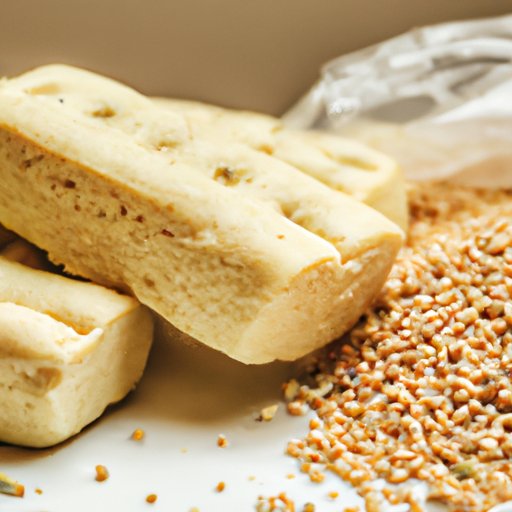
Introduction
Bread is a staple food in our diets, but for people with gluten allergies,
eating this food can cause unpleasant reactions in their bodies. Fortunately,
there are gluten-free bread alternatives available for people with gluten intolerance or celiac disease. In this article, we will delve deep into the topic of
gluten-free bread, including its definition, types, and tips for making it at home. We will also explore the pros and cons of a gluten-free diet and evaluate whether gluten-free bread is worth the hype. To wrap things up, we’ll take a look at some of the top gluten-free bread brands and alternatives available in the market.
Understanding Gluten-Free Bread
Gluten is a type of protein found in grains such as wheat, barley, and rye. It
provides bread with its elasticity and chewy texture. However, for people with gluten-related issues, consuming gluten can lead to digestive problems, allergic reactions, and other symptoms.
Gluten-free bread is made using a combination of flours such as rice flour,
almond flour, or potato flour, instead of regular wheat flour. It can be found in most grocery stores in the gluten-free section, frozen section, or health food aisle. Alternatively, if you want to make your gluten-free bread, you can use gluten-free flour or a bread mix with added ingredients such as yeast, sugar, and salt.
For those who want to make gluten-free bread at home, there are also several tips and tricks to keep in mind. For example, mixing different types of gluten-free flour can enhance the texture and flavor of your bread. You can also experiment with adding various herbs or spices for extra flavor.
Pros and Cons of a Gluten-Free Diet
For people with celiac disease or gluten intolerance, a gluten-free diet is critical to their health and wellbeing. By eliminating gluten from their diet, they can alleviate many of the symptoms associated with gluten intolerance, such as bloating, abdominal pain, and diarrhea. Additionally, people report feeling less fatigued and more energetic after adopting a gluten-free diet.
However, there are also potential downsides to a gluten-free diet. For example, gluten-free alternatives tend to be more expensive than their traditional counterparts. Additionally, some gluten-free products may contain less fiber and nutrients, which can lead to nutritional deficiencies in the long run.
When it comes to gluten-free bread, we must evaluate whether it’s worth the hype. Gluten-free bread can come in a range of textures and flavors, which can differ significantly from traditional bread. Nevertheless, gluten-free bread can be a game-changer for people who are struggling with gluten-related issues and want a healthier alternative to traditional bread.
Top Gluten-Free Bread Brands and Varieties
Several excellent gluten-free bread brands and varieties are currently available in the market, catering to different preferences and dietary restrictions. One of the most popular options is sourdough bread, which is made using gluten-free sourdough starter and various gluten-free flours such as rice, almond, and tapioca flour. Sourdough bread is an excellent choice for people who are looking for a bread option with a distinctive taste and texture.
Pita bread is another excellent gluten-free bread option available in the market.
It has a chewy texture, and its pocket-like shape makes it an excellent choice for filling with your favorite fillings. Other popular bread varieties include wraps, bagels, and hamburger buns.
It’s essential to choose your bread carefully based on its ingredients, taste, and texture. Some gluten-free bread may be dry and crumbly, while others may be too dense or moist.
Substituting Traditional Bread with Gluten-Free Alternatives
Transitioning to a gluten-free diet can be overwhelming, but there are several substitutes available that can satisfy your bread cravings without feeling like you’re missing out. Some traditional bread substitutes include lettuce wraps, corn tortillas, and rice cakes.
If you want to make sandwiches or toast, consider using gluten-free bread options like English muffins, bagels, and pita bread. You can also wrap your favorite fillings in gluten-free tortillas or flatbreads.
When choosing substitute options, it’s essential to keep in mind, flavor, nutritional value, and availability. Some gluten-free substitutes may be low in fiber or contain added sugars, affecting their nutritional value.
The Science of Gluten and its Effects on the Body
Gluten intolerance or celiac disease is an autoimmune disease that affects the small intestine’s lining when gluten is consumed. Gluten triggers an immune response that can cause digestive symptoms such as bloating, gas, and diarrhea. Over time, gluten ingestion can lead to nutrient deficiencies, anemia, and severe medical conditions.
Research has also indicated that gluten consumption could cause cognitive impairments, such as brain fog, headaches, and fatigue in some individuals. Eliminating gluten from the diet can help improve these symptoms for those experiencing them.
Incorporating Gluten-Free Alternatives into your Diet
Going gluten-free doesn’t have to be boring or limiting. Using gluten-free flours or bread in recipes like French toast or banana bread can add flavor and texture. Doubling up on salad or soup as an alternative to sandwiches is a great idea. You can also use gluten-free bread as a side dish while enjoying your favorite stews or stir-fries.
When dining out, you can ask for gluten-free options or seek advice from gluten-free communities on social media platforms. If you’re new to eating gluten-free, it’s essential to stay positive, try new flavors and products, and don’t hesitate to seek support from others.
Conclusion
Switching to a gluten-free diet can be challenging, but incorporating gluten-free alternatives and exploring a range of gluten-free bread options makes the transition easier and more fun. With so many delicious gluten-free options available, it’s never been easier to lead a healthy and active lifestyle.
It’s time to take action towards a healthier life and consider including gluten-free alternatives and bread into your diet.





